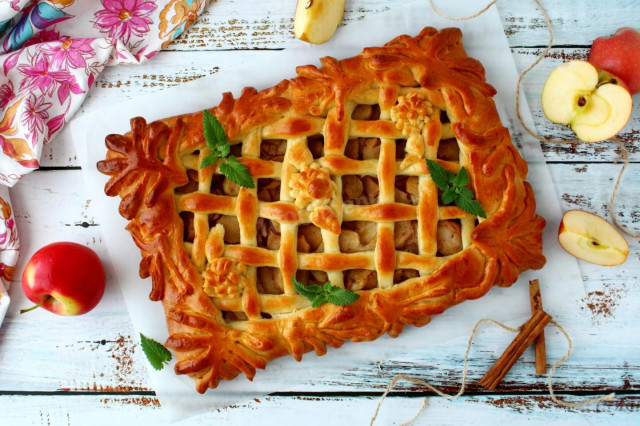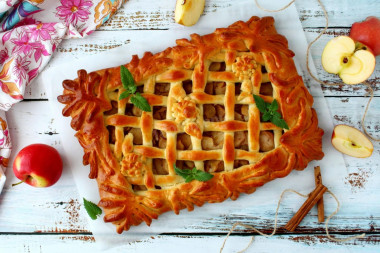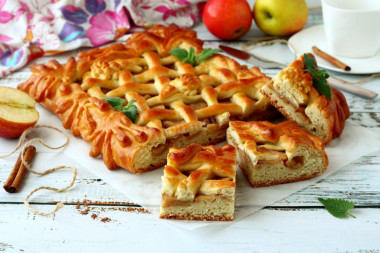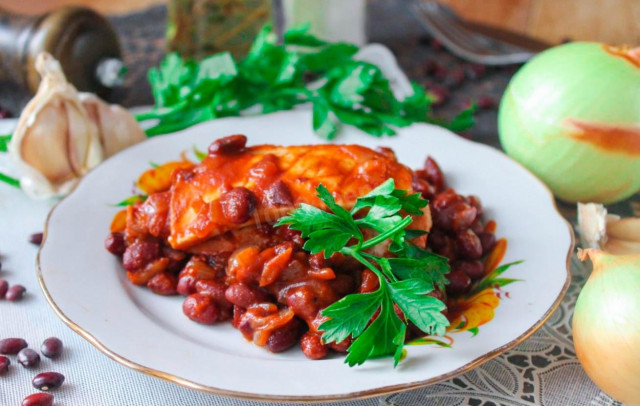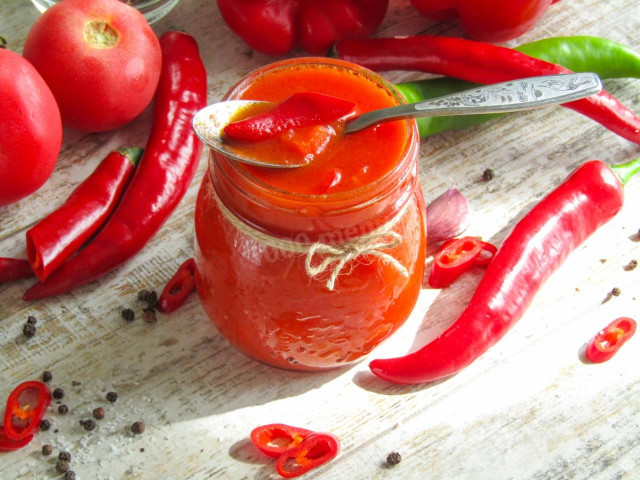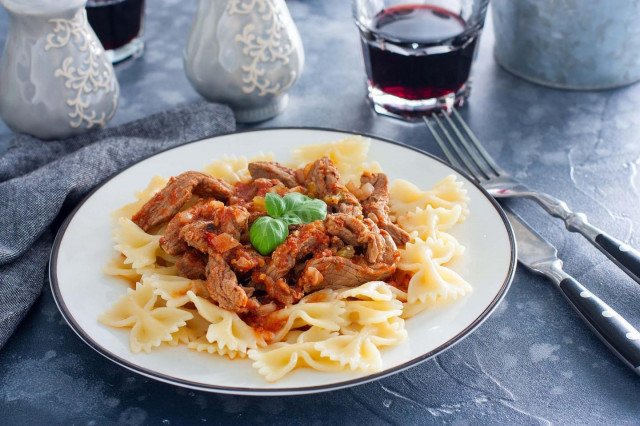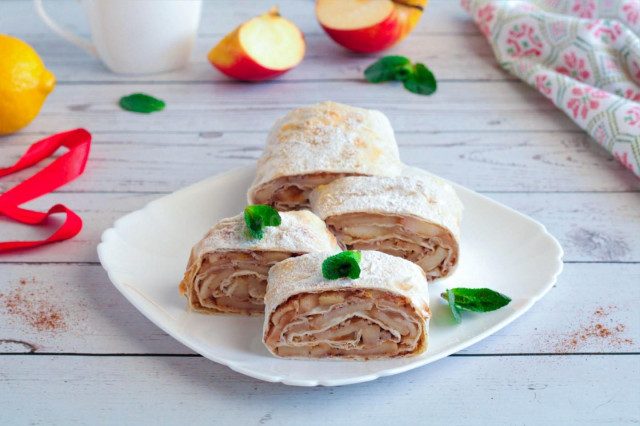Composition / ingredients
Step-by-step cooking
Step 1:
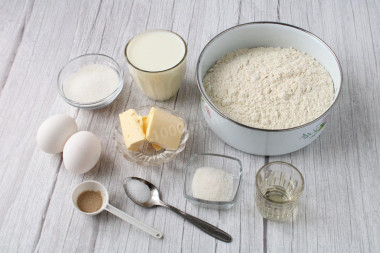
How to bake a pie with apples from yeast dough? Prepare the necessary ingredients. They should be at room temperature. Heat the milk slightly so that the process of lifting the dough goes faster. Take wheat flour of the highest grade. According to the gluten content, it is most suitable for making yeast muffins.
Step 2:

Activate the yeast first. In a small but high-sided bowl, combine yeast, 1 tsp sugar and 50 ml of warm milk, mix well. Leave the yeast mixture for 10-15 minutes until a foam cap forms. If the "cap" does not appear or rises weakly and for a long time, then the yeast is not active enough and it is better to replace them. On such yeast, the dough will not be successful and there is a risk of wasting both time and effort.
Step 3:
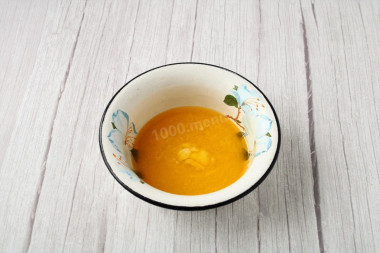
Melt the butter over low heat. This can also be done in the microwave. The oil should cool down.
Step 4:
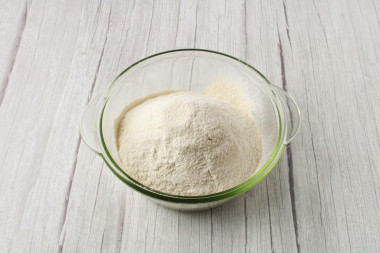
Sift the flour through a sieve. To do this, take a spacious, wide bowl so that the flour does not spill out on the table when sifting. Why sift flour? Sifting will increase the oxygen content in the flour, thanks to this the dough will be easier to rise and will turn out lush and airy.
Step 5:

Choose a suitable container for kneading the dough. Beat the eggs until smooth. How to beat eggs? You can use a whisk or fork. You won't need a mixer here.
Step 6:

Add sugar, vanilla sugar and salt to the beaten eggs. Whisk again until the dry ingredients are partially dissolved.
Step 7:
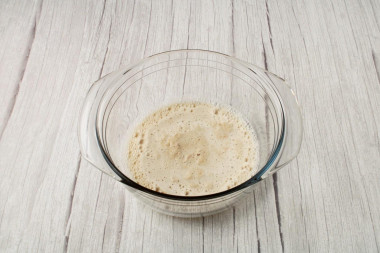
Pour in the yeast mixture, stir with a spoon.
Step 8:
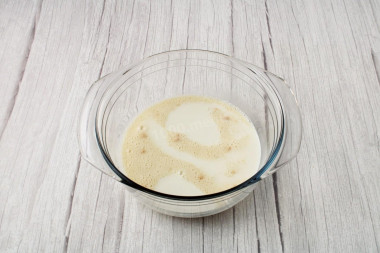
Add the rest (150 ml) of warm milk, stir.
Step 9:

Pour in the butter, mix. The oil should not be hot, it is acceptable if it is only slightly warm. Otherwise, it will affect the action of yeast.
Step 10:

Pour the sifted flour into the liquid mass. You can do this through a sieve, thereby sifting it twice. Do not add all the flour at once, so as not to make the dough tight and heavy. First add about 3/4 of the total amount, mix with a spoon.
Step 11:
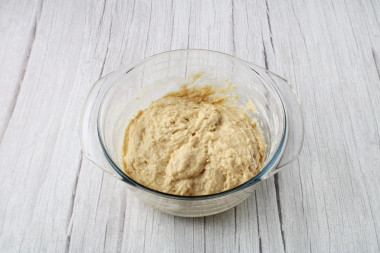
The dough turns out to be still very sticky.
Step 12:
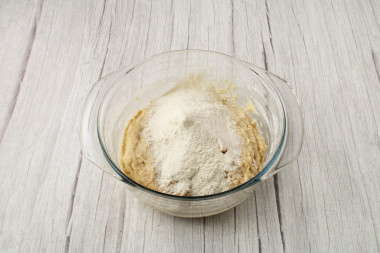
Then add the flour in small portions, stirring the dough with your hands each time and controlling its density.
Step 13:
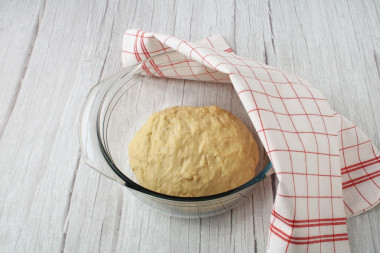
The dough should be soft, pliable, homogeneous. It practically does not stick to your hands. Form a ball from the dough, cover it with a towel so that it does not wind up. Leave the dough in a warm place to rise.
Step 14:

While the dough is coming, prepare the filling. Take large apples, if the fruits are small, then increase their number.
Step 15:
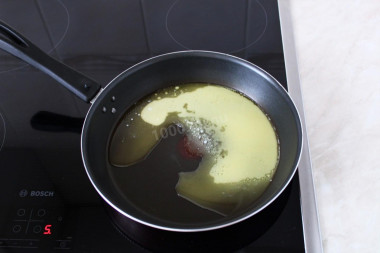
Melt the butter in a wide frying pan.
Step 16:
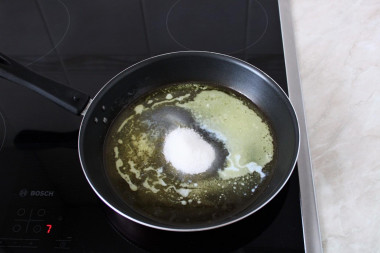
Add sugar to the pan, stir. Adjust the amount of sugar, focusing on your taste and sweetness of apples.
Step 17:
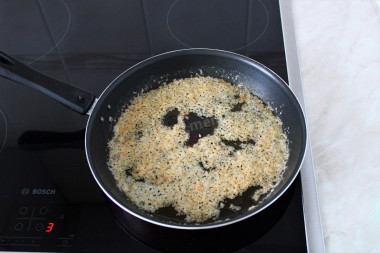
Over moderate heat, with frequent stirring, bring the sweet butter mixture to a light caramel color.
Step 18:

Wash the apples, peel and peel the seeds. Slice the apples randomly. You can use not too thin plates or cubes.
Step 19:

Put the prepared apples in a frying pan, mix.
Step 20:
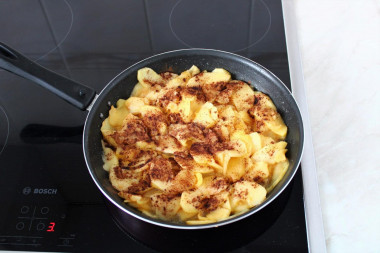
Cook the filling over medium heat until the apple slices are moderately soft. At the same time, gently mix the filling with a wooden spatula so that the apples stew evenly. At the end of cooking, sprinkle the apples with cinnamon, mix. Adding cinnamon is a matter of taste. If you don't like the spice, don't add it.
Step 21:
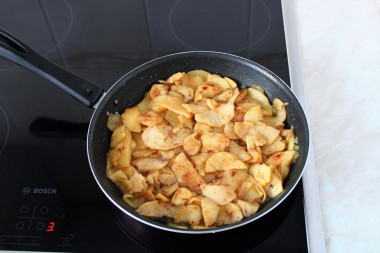
Simmer the apples for 1 minute and remove from the stove. The filling should be cooled to room temperature. To make it happen faster, put it in a separate cup.
Step 22:
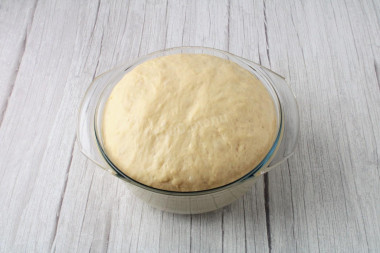
The dough has risen well, increasing in volume by about 2.5 times. In my case, it happened in 1 hour and 20 minutes. The rise time of the dough will depend on the ambient temperature and yeast activity.
Step 23:

Sprinkle the work surface with flour. Gently knead the dough, put it on the table. Divide the dough into 2 unequal parts. The smaller part is used to decorate the top of the pie. Cover it with a towel so that it does not dry out while we are forming the pie.
Step 24:
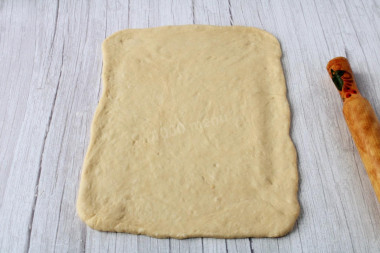
How to form an open pie? I was making a rectangular pie. You can make it round or square and bake it in any suitable shape. It was more convenient for me to make such a pie on a baking sheet than in a form with sides. Choose a suitable option for yourself. Roll out the dough on a floured table into a layer. I wanted the thickness of the bottom crust of the pie and the filling to be about the same, so I rolled out the dough with a thickness of no more than 7-8 mm.
Step 25:

I made the edges of the layer a little thinner, since they will bend over the filling. Carefully wrap the dough on a rolling pin and transfer to a sheet covered with parchment.
Step 26:
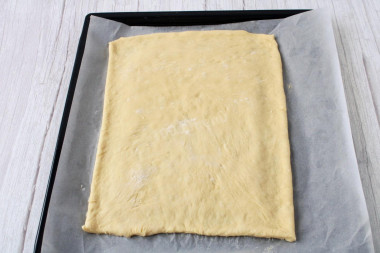
The dough is very soft, pliable. If it is slightly deformed during the transfer, it is easy to correct and give the desired shape. If necessary, lubricate the baking dish with vegetable oil.
Step 27:
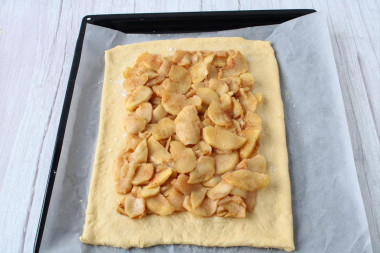
Spread the apple filling evenly on the dough, leaving 3-4 cm free from each edge.
Step 28:
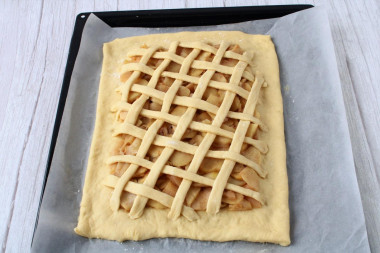
Separate a part from a smaller piece of dough, roll out, cut into strips 1 cm wide. Lay the strips on top of the filling in the form of a mesh.
Step 29:
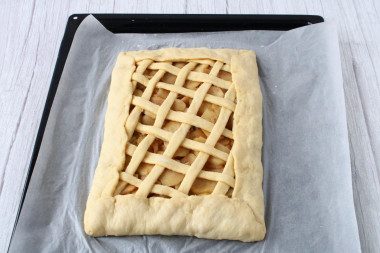
Fold the edges of the dough into the filling. Connect the corners-joints so that they do not disperse during baking.
Step 30:
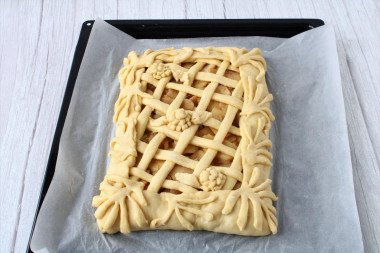
From the rest of the dough, make any decoration at will so that the cake is more elegant. You can skip steps 24-30 and make a pie according to your imagination and desire.
Step 31:

In a small bowl with a fork, beat the egg with milk until smooth.
Step 32:
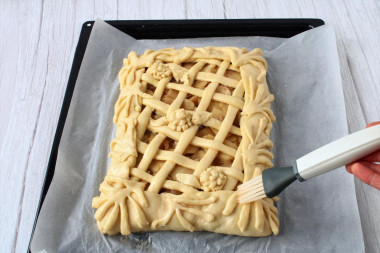
Using a cooking brush, smear the top of the pie with beaten egg so that during baking the pie gets a ruddy color. While I was decorating the pie, the dough still fit well, so no additional proofing was required.
Step 33:

Bake the apple pie in a preheated 180 degree oven until ready. If the wooden skewer comes out of the dough dry, then the pie is ready. The baking time will depend on the size, thickness of the pie, as well as on the specifics of the oven. I got a pie 32 * 22 cm and baked for about 40 minutes. If the top of the baking is prematurely browned, and the cake is not ready inside, cover it with a sheet of foil.
Step 34:
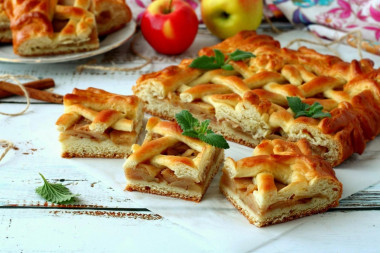
Cool the finished pastries completely, cut into portions and serve. Have a nice tea party!
Butter yeast dough according to this recipe never fails. Baking from it always turns out to be successful. The bottom crust of the pie is very tasty, soaked with the juiciness of the apple filling. Thanks to the muffin, the pie remains soft for a long time and does not become stale.
Dry yeast can be replaced with fresh pressed yeast, based on the proportion of 1:3. That is, for 1 gram of dry yeast required by the recipe, you need to take 3 grams of fresh.
Be prepared for the fact that flour may need more or less than indicated in the recipe. Focus not on the amount of flour, but on the desired consistency of the dough. To avoid mistakes, read about flour and its properties!
Important! Using dry yeast, it should be borne in mind that they occur in two forms: active and instant (read the instructions carefully before use!).
Active dry yeast looks like beads or small balls. Before applying them, they must be brought out of "sleep mode". To do this, the active yeast is diluted in warm sweet water, milk or whey. The resulting bubbles, foam or "cap" indicate that the yeast is ready for further use. Active dry yeast must be brought to complete dissolution in the liquid, otherwise, due to the remaining grains, the dough may not rise and the baking will be spoiled (yeast grains that have not dissolved in the liquid and got into the dough will not disperse on their own, which means they will not work).
Instant dry yeast is easier to use. They do not need to be activated before use. Such yeast, along with other ingredients, is simply added to the dough. As a result, the baking time is reduced.
It should also be remembered that both types of dry yeast may differ in their activity from different manufacturers.
Keep in mind that everyone's ovens are different. The temperature and cooking time may differ from those specified in the recipe. To make any baked dish successful, use useful information about the features of ovens !
Caloric content of the products possible in the composition of the dish
- Whole cow's milk - 68 kcal/100g
- Milk 3.5% fat content - 64 kcal/100g
- Milk 3.2% fat content - 60 kcal/100g
- Milk 1.5% fat content - 47 kcal/100g
- Concentrated milk 7.5% fat content - 140 kcal/100g
- Milk 2.5% fat content - 54 kcal/100g
- Chicken egg - 157 kcal/100g
- Egg white - 45 kcal/100g
- Egg powder - 542 kcal/100g
- Egg yolk - 352 kcal/100g
- Ostrich egg - 118 kcal/100g
- Apples - 47 kcal/100g
- Dried apples - 210 kcal/100g
- Canned apple mousse - 61 kcal/100g
- Granulated sugar - 398 kcal/100g
- Sugar - 398 kcal/100g
- Butter 82% - 734 kcal/100g
- Amateur unsalted butter - 709 kcal/100g
- Unsalted peasant butter - 661 kcal/100g
- Peasant salted butter - 652 kcal/100g
- Melted butter - 869 kcal/100g
- Vegetable oil - 873 kcal/100g
- Salt - 0 kcal/100g
- Wheat flour - 325 kcal/100g
- Vanilla sugar - 379 kcal/100g
- Dry yeast - 410 kcal/100g
- Ground cinnamon - 247 kcal/100g

